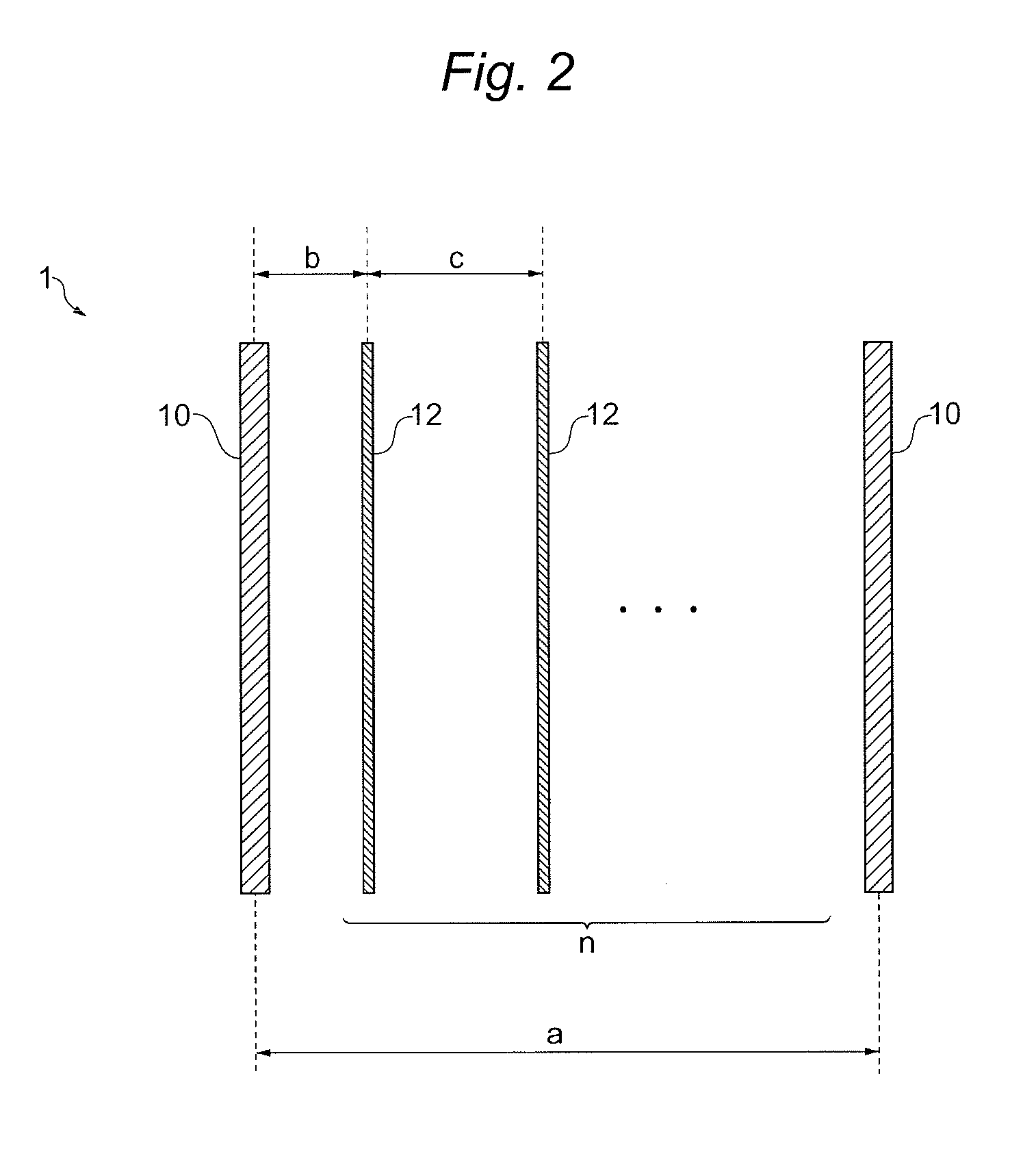Cation exchange membrane, electrolysis vessel using the same and method for producing cation exchange membrane
- Summary
- Abstract
- Description
- Claims
- Application Information
AI Technical Summary
Benefits of technology
Problems solved by technology
Method used
Image
Examples
example 1
[0150]As a reinforcing core material, a monofilament of polytetrafluoroethylene (PTFE) of 90 deniers (hereinafter referred to as a “PTFE yarn”) was used. As a sacrifice yarn, a yarn of 6-filament polyethylene terephthalate (PET) of 40 deniers twisted at a rate of 200 times / m (hereinafter referred to as a “PET yarn”) was used. As a dummy yarn, a yarn of 15-filament polyvinyl alcohol (PVA) of 36 deniers twisted at a rate of 200 times / m (hereinafter referred to as a “PVA yarn”) was used.
[0151]First, PTFE yarns were arranged at a rate of 24 yarns / inch at approximately equal intervals. MD yarns were prepared by use of a continuous 3-dent reed as follows. A bundle of 2 yarns consisting of PTFE yarn and PET yarn was passed through a first reed; a bundle of 2 yarns consisting of PET yarn and PTFE yarn was passed through a second reed; and a bundle of 2 yarns consisting of PET yarn and PET yarn was passed through a third reed. The bundles of yarns in this combination were sequentially and re...
example 2
[0160]A cation exchange membrane was prepared by using the same materials as in Example 1 except that a yarn (PVA yarn) of 15-filament polyvinyl alcohol (PVA) of 28 deniers twisted 200 times / m was used as a dummy yarn.
[0161]In the obtained cation exchange membrane, in the TD direction, the distance a2 between the reinforcing core materials adjacent to each other was 1005 μm, the number n of elution holes provided between the adjacent reinforcing core materials was 2 and the distance c2 of the adjacent elution holes was 373 μm. According to calculation, the distance c2 was expressed by 1.11a2 / (n+1) (see FIG. 8, the same hereinafter).
[0162]Furthermore, in the TD direction, in the distance a1 between the reinforcing core materials adjacent to each other of 1091 μm, the number n of elution holes provided between the adjacent reinforcing core materials was 2 and the distance c1 of the adjacent elution holes was 252 μm. According to calculation, the distance c1 was expressed by 0.69a1 / (n+...
example 3
[0166]First, PTFE yarns were arranged at a rate of 24 yarns / inch at approximately equal intervals. MD yarns were prepared by use of a continuous 3-dent reed as follows. A bundle of 2 yarns consisting of PTFE yarn and PET yarn was passed through a first reed; a bundle of 2 yarns consisting of PET yarn and PTFE yarn was passed through a second reed; and a bundle of 2 yarns consisting of PET yarn and PET yarn was passed through a third reed. Weaving of the bundles of yarns in this combination was repeated in this order to obtain a plain weave. As to TD yarns, PTFE yarn, PVA yarn, PVA yarn, PET yarn, PET yarn, PVA yarn and PVA yarn were arranged in this order repeatedly and at approximately equal intervals to obtain a plain weave. In this manner, a woven fabric (reinforcing material) was obtained. Subsequently, the obtained reinforcing material was subjected to contact bonding performed by a roll heated to 125° C. Thereafter, the reinforcing material was soaked in a 0.1 N aqueous sodium...
PUM
| Property | Measurement | Unit |
|---|---|---|
| Volume | aaaaa | aaaaa |
| Distance | aaaaa | aaaaa |
Abstract
Description
Claims
Application Information
 Login to View More
Login to View More - R&D
- Intellectual Property
- Life Sciences
- Materials
- Tech Scout
- Unparalleled Data Quality
- Higher Quality Content
- 60% Fewer Hallucinations
Browse by: Latest US Patents, China's latest patents, Technical Efficacy Thesaurus, Application Domain, Technology Topic, Popular Technical Reports.
© 2025 PatSnap. All rights reserved.Legal|Privacy policy|Modern Slavery Act Transparency Statement|Sitemap|About US| Contact US: help@patsnap.com



